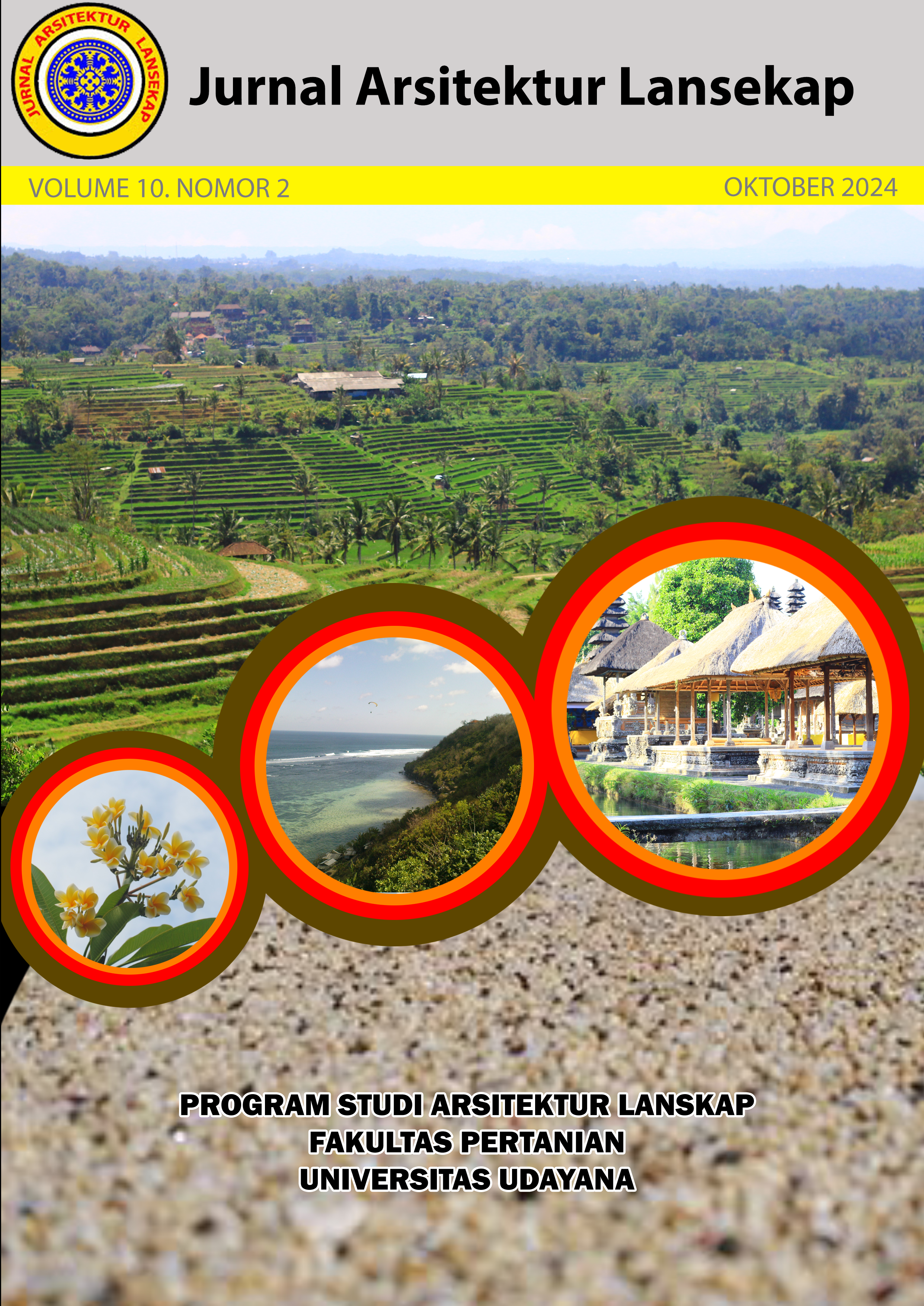Elemen-Elemen Lansekap Taman Ghairah dalam Bustanussalatin
Abstract
Bustanussalatin is a well-known work of Nuruddin Ar-Raniry, which contains detailed descriptions of a garden called Taman Ghairah. The manuscript was written in the seventeenth century in Aceh. This study aims to identify and enlist the landscape elements in Taman Ghairah, as mentioned in Bustanussalatin. The methods used in this study were content analysis of the copy of the Bustanussalatin manuscript and classified them according to the current knowledge of landscape architecture classification. The result shows that the landscape elements of Taman Ghairah, as written in Bustanussalatin, can be classified into soft elements, hard elements, and buildings. The findings of this research can be used as a reference for landscape design based on the history or locality in Aceh.
Downloads
References
Fadhil, M. N., Putri, A. S., & Nichols, J. (2022). Pre-Islamic and Islamic Influences of Taman Ghairah Aceh. Heritage of Nusantara: International Journal of Religious Literature and Heritage, 11(2), 171-205.
Fadhil, M. N. (2015). Taman Ghairah Aceh: simbol arsitektur pra-islam dalam taman islam. [Universitas Indonesia]. https://lib.ui.ac.id/detail.jsp?id=20411581&lokasi=lokal
Fakriah, N. (2021). ISLAMIC GARDEN CONCEPT IN BUSTANUSSALATIN (GARDEN OF THE KINGS), ACEH, INDONESIA. Journal of Islamic Architecture, 6(3).
Hakim, R., & Utomo, H. (2003). Komponen perancangan arsitektur lansekap. Jakarta: Bumi Aksara.
Harun, J. (2004). Bustan Al‐Salatin , ‘the garden of kings’: A universal history and ADAB work from seventeenth‐century ACEH. Indonesia and the Malay World, 32(92), 21–52. https://doi.org/10.1080/1363981042000263444
Hooykaas, J. (1957). Upon a white stone under a nagasari-tree. Bijdragen Tot de Taal-, Land- En Volkenkunde / Journal of the Humanities and Social Sciences of Southeast Asia, 113(4), 324–340. https://doi.org/10.1163/22134379-90002279
Iskandar, T. (1966). Bustanussalatin Bab II Fasal 13. Percetakan Bahasa dan Pustaka.
Lombard, D. (2014). Kerajaan Aceh Zaman Sultan Iskandar Muda (1607-1636). KPG.
Nasruddin, A. S. (2020). Gunongan Kesultanan Aceh (Kajian Arkeologi Sejarah). Jurnal Adabiya, 16(31), 29–46.
Purnomo, A. B. (2006). Waterfront Development Concepts According to Nuruddin Arraniry’s Bustanussalatin. International Seminar, Exhibition, Networking Development, Excursion “Waterfront Development.” International Seminar, Exhibition, Networking Development, Excursion “Waterfront Development.”
Restiyadi, A., & Syam, A. I. (2018). Gaya Ornamentasi Gunongan. Berkala Arkeologi Sangkakhala (BAS), 21(1), 16–34.
Wulandari, E., Soetomo, S., Syahbana, J. A., & Manaf, A. (2017). The Ecology Character Of Banda Aceh City In The 17th Century. Journal of Islamic Architecture, 4(3), 93. https://doi.org/10.18860/jia.v4i3.3872
Wessing, R. (1991). An Enclosure in the Garden of Love. Journal of Southeast Asian Studies. vol. 22, no. 1, pp. 1-15.

This work is licensed under a Creative Commons Attribution-ShareAlike 4.0 International License.
An author who publishes in the Jurnal Arsitektur Lansekap (JAL) agrees to the following terms:
- Author retains the copyright and grants the journal the right of first publication of the work simultaneously licensed under the Creative Commons Attribution-ShareAlike 4.0 License that allows others to share the work with an acknowledgement of the work's authorship and initial publication in this journal
- Author is able to enter into separate, additional contractual arrangements for the non-exclusive distribution of the journal's published version of the work (e.g., post it to an institutional repository or publish it in a book) with the acknowledgement of its initial publication in this journal.
- Author is permitted and encouraged to post his/her work online (e.g., in institutional repositories or on their website) prior to and during the submission process, as it can lead to productive exchanges, as well as earlier and greater citation of the published work (See The Effect of Open Access).
Read more about the Creative Commons Attribution-ShareAlike 4.0 Licence here: https://creativecommons.org/licenses/by-sa/4.0/.







